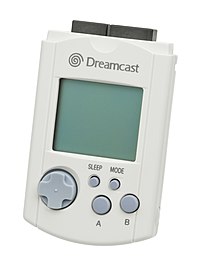
Back Visual Memory German VMU Spanish VMU Finnish VMU French Visual Memory Unit Galician VMU ID Visual Memory Unit Italian ビジュアルメモリ Japanese Visual Memory Unit LMO VMU Polish
 | |
| Manufacturer | Sega |
|---|---|
| Type | Peripheral, handheld game system |
| Generation | Sixth |
| Release date |
|
| Lifespan | 1998–2001 |
| Discontinued |
|
| Media | Dreamcast GD-ROM (used for content transfer) |
| CPU | 8-bit Sanyo LC8670 |
| Storage | 100 KB (200 blocks) accessible 28 KB (56 blocks) system data |
| Input |
|
| Power | 2 × CR2032 lithium batteries |
| Mass | 45g |
The Visual Memory Unit (VMU), also referred to as the Visual Memory System (ビジュアルメモリ, Bijuaru Memori) (VMS) in Japan and Europe, is the primary memory card produced by Sega for the Dreamcast home video game console. The device features a monochrome liquid crystal display (LCD), multiplayer gaming capability (via connectors at the top), second screen functionality, a real-time clock, file manager, built-in flash memory, and sound capability. Prior to the launch of the Dreamcast, a special Godzilla edition VMU, preloaded with a virtual pet game, was released on July 30, 1998, in Japan.[1]
While its most basic function is as a removable storage device, the VMU may also serve as an auxiliary display during normal gameplay and, through the use of additional software (distributed as extras on Dreamcast GD-ROMs), acts as a handheld game console. Console-like features of the VMU include a screen, speaker, proper directional pad, four action buttons, the ability to connect and interact with other VMUs, and the ability to download additional games.
- ^ "Dreamcast Visual Memory Card VMS/VMU (Godzilla Design)". Play-Asia. Retrieved October 5, 2014.
© MMXXIII Rich X Search. We shall prevail. All rights reserved. Rich X Search